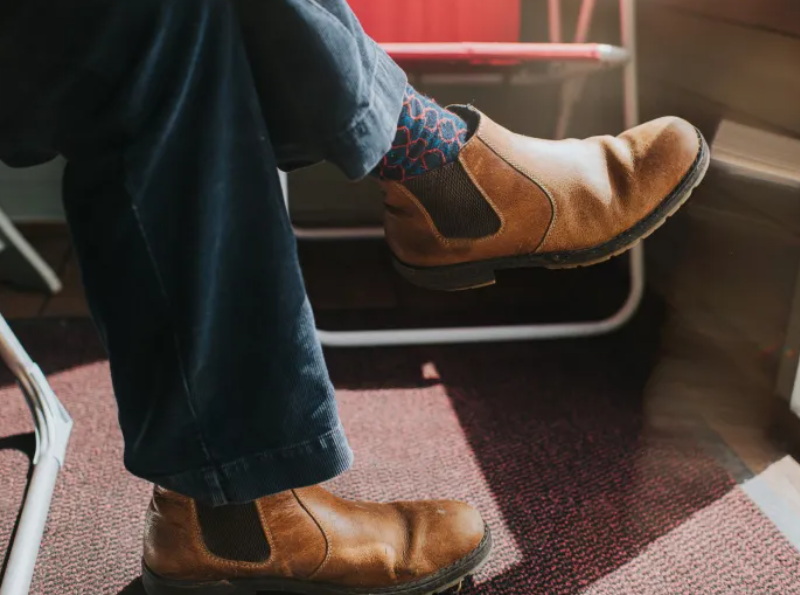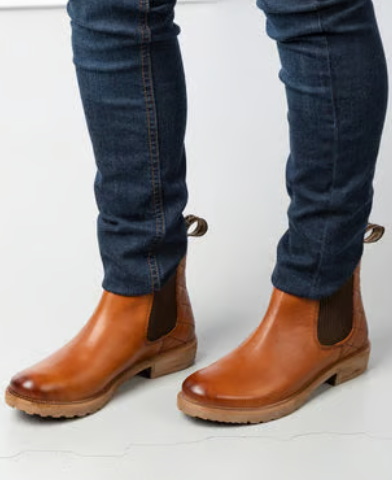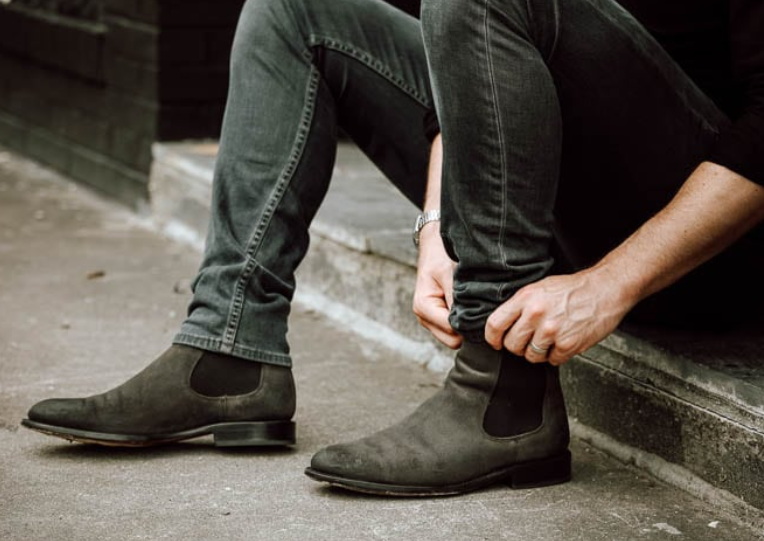Content Menu
● The Importance of a Proper Fit
● Heel Fit: The Foundation of Comfort
● Toe Box: Room to Breathe
● Width: Accommodating Your Foot Shape
● Ankle Fit: The Signature Chelsea Boot Feature
● Length: Finding the Right Size
● The Try-On Process
● Breaking In Your Chelsea Boots
● Sizing Considerations
● Style and Fit
● Common Fit Issues and Solutions
● Conclusion
● FAQ
>> 1. How tight should Chelsea boots be?
>> 2. Do Chelsea boots stretch over time?
>> 3. Should I size up or down for Chelsea boots?
>> 4. How do I know if my Chelsea boots are too big?
>> 5. Can I wear Chelsea boots with orthotics?
Chelsea boots are a timeless classic in the world of footwear, known for their sleek design and versatility. Whether you're dressing up for a formal occasion or going for a casual look, these boots can complement various outfits. However, to truly enjoy the comfort and style of Chelsea boots, it's crucial to understand how they should fit. In this comprehensive guide, we'll explore the nuances of Chelsea boot fit, from the heel to the toe, and provide you with expert tips to ensure you find the perfect pair.

The Importance of a Proper Fit
A well-fitting Chelsea boot not only enhances your comfort but also prolongs the life of the footwear. When Chelsea boots fit correctly, they provide support, prevent blisters, and maintain their shape over time. Let's delve into the key areas to consider when assessing the fit of your Chelsea boots.
Heel Fit: The Foundation of Comfort
The heel fit is perhaps the most critical aspect of a Chelsea boot's overall fit[6]. Since these boots lack laces, the snugness around the heel is what keeps them securely on your feet. Here's what to look for:
- Snug but Not Tight: Your heel should feel securely held in place without any pinching or excessive pressure[1].
- Minimal Movement: There should be very little to no heel slippage when you walk[4].
- Easy Entry: While the fit should be snug, you should still be able to slip your foot in without excessive force[4].
Toe Box: Room to Breathe
The toe box of your Chelsea boots should provide comfort without compromising on style. Here's how to ensure a proper fit:
- Wiggle Room: You should be able to wiggle your toes freely[1].
- Thumb's Width: Aim for about a half-inch (roughly a thumb's width) of space between your longest toe and the end of the boot[6].
- No Pinching: The sides of the toe box shouldn't squeeze your feet[4].
Width: Accommodating Your Foot Shape
The width of Chelsea boots is crucial for all-day comfort. Consider these points:
- Snug Sides: The boot should hug the sides of your feet without causing discomfort[6].
- No Pressure Points: Ensure there are no areas where the boot presses uncomfortably against your foot[4].
- Account for Swelling: Remember that feet tend to swell throughout the day, so a bit of extra width can be beneficial[6].
Ankle Fit: The Signature Chelsea Boot Feature
The elasticated sides are a defining feature of Chelsea boots. Here's how they should fit:
- Gentle Grip: The elastic should provide a secure fit around your ankle without being too tight[1].
- Easy On and Off: You should be able to slip the boots on and off with relative ease[4].
- No Gaping: There shouldn't be a significant gap between the boot and your ankle[5].

Length: Finding the Right Size
The overall length of the boot is important for both comfort and aesthetics:
- Toe Space: Ensure there's enough room in front of your toes to prevent discomfort[6].
- Heel Cup: Your heel should sit comfortably in the heel cup without slipping out[4].
- Arch Support: The boot should provide adequate support along the length of your foot[4].
The Try-On Process
When fitting Chelsea boots, follow these steps for the best results:
1. Wear Appropriate Socks: Use the type of socks you plan to wear with the boots regularly[6].
2. Try On Later in the Day: Your feet naturally swell as the day progresses, so trying on boots in the afternoon or evening gives a more accurate fit[6].
3. Walk Around: Take a few steps to assess comfort and any potential slippage[2].
4. Use the Pull Tabs: When putting on the boots, use the pull tabs to avoid stretching the elastic sides unnecessarily[4].
Breaking In Your Chelsea Boots
Even with a perfect fit, new Chelsea boots may require a breaking-in period:
- Gradual Wear: Start by wearing them for short periods and gradually increase the duration.
- Leather Care: Apply leather conditioner to help soften the material and prevent cracking.
- Patience: Remember that quality leather will mold to your feet over time, improving the fit.
Sizing Considerations
Chelsea boot sizing can vary between brands and styles. Here are some general guidelines:
- True to Size: Many Chelsea boots run true to size, but always check the brand's specific sizing recommendations[5].
- Width Options: Some brands offer different width fittings, which can be crucial for a comfortable fit[4].
- Size Conversion: Be aware of UK, US, and EU size differences when shopping internationally[7].
Style and Fit
While fit is paramount, style also plays a role in how your Chelsea boots should sit:
- Trouser Length: Ideally, trousers should fall no more than an inch below the top of the boot to maintain a sleek look[8].
- Ankle Height: Chelsea boots typically cover the ankle, providing protection and a classic silhouette[4].
- Toe Shape: Consider how the toe shape affects the overall fit and style of the boot[4].
Common Fit Issues and Solutions
Even with careful selection, you may encounter fit issues. Here are some common problems and how to address them:
- Heel Slippage: Try using heel grips or inserts to improve the fit.
- Too Tight: Consider stretching the boots or opting for a wider size.
- Too Loose: Use insoles or wear thicker socks to improve the fit[6].
Conclusion
Finding the perfect fit for Chelsea boots is a combination of understanding your foot shape, knowing what to look for in terms of fit, and being patient during the breaking-in process. Remember that a well-fitting Chelsea boot should feel snug but not tight, with enough room for your toes to move comfortably. The heel should be secure, the width should accommodate your foot without pinching, and the ankle should have a gentle, supportive grip.
By following the guidelines outlined in this article, you'll be well-equipped to find a pair of Chelsea boots that not only look great but also provide lasting comfort. Remember, the right fit can make all the difference in your enjoyment and the longevity of your boots.

FAQ
1. How tight should Chelsea boots be?
Chelsea boots should fit snugly around the ankle and heel without being uncomfortably tight. There should be enough room in the toe box for your toes to wiggle, and the width should comfortably accommodate the broadest part of your foot without pinching[1][4].
2. Do Chelsea boots stretch over time?
Yes, Chelsea boots, especially those made of leather, will typically stretch and mold to your feet over time. However, it's important to buy boots that fit well from the start, as excessive stretching can compromise the boot's structure and support[4].
3. Should I size up or down for Chelsea boots?
In most cases, you should stick to your true size when buying Chelsea boots. However, if you're between sizes, it's generally better to size up slightly rather than down, as you can always add insoles or wear thicker socks to improve the fit[5][6].
4. How do I know if my Chelsea boots are too big?
Signs that your Chelsea boots are too big include excessive heel slippage when walking, a large gap between your ankle and the boot's opening, and your foot sliding forward in the boot. If you can fit more than a thumb's width of space in front of your toes, the boots are likely too large[1][5].
5. Can I wear Chelsea boots with orthotics?
Many Chelsea boots can accommodate orthotics, but it's important to try them on with your orthotics in place. Look for boots with removable insoles, which can be replaced with your custom orthotics. You may need to size up to ensure enough depth and width to comfortably fit your orthotics[4].
##Citations:
[1] https://martindingman.com/pages/chelsea-boot-buying-guide
[2] https://www.youtube.com/watch?v=V_AsxR9huX4
[3] https://www.reddit.com/r/Boots/comments/18fzehu/chelsea_boots_sizing/
[4] https://www.ahume.co.uk/blog/chelsea-boots-the-ultimate-buyers-guide/
[5] https://www.shoezone.com/Images/Static/Blog/the-low-down-on-chelsea-boots-2.jpg?sa=X&ved=2ahUKEwiGpdLl6dWKAxWXlIkEHb3FFxQQ_B16BAgFEAI
[6] https://bootspy.com/how-should-chelsea-boots-fit/
[7] https://www.portlandleathergoods.com/pages/mens-chelsea-boot-size-guide
[8] https://tblon.com/blogs/news/chelsea-boots

















